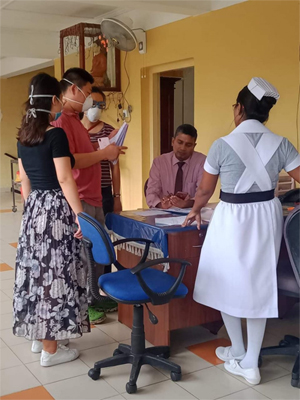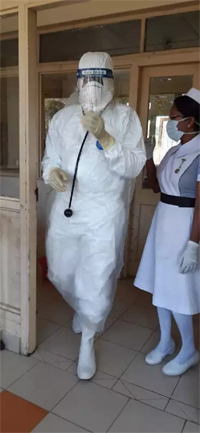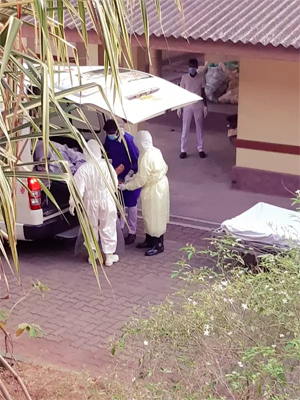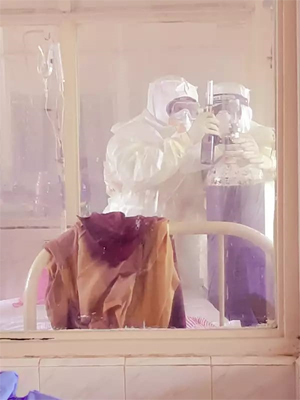News
Battling COVID-19: From the frontline at NIID to getting a few hours of sleep at home

Out of the PPE, Consultant Physician Dr. Eranga Narangoda discharges some patients who have recovered
Life and death……the world including Sri Lanka has been brought to its knees by a tiny virus. Many have died and many more will die and for those who survive this holocaust, life will never be the same again.
Across the globe whether it is China, Australia, South Korea, Saudi Arabia, Italy, Spain, the United Kingdom or the United States of America, there are the ‘front-liners’ who are waging a battle every second of every day against this not-much-known quantity – the Severe Acute Respiratory Syndrome-Coronavirus 2 (SARS-CoV2) which is felling people through the disease of COVID-19.
These ‘front-liners’ are the healthcare staff, the unsung heroes rendering a silent but essential service, who wrestle with this enemy day in day out to save lives, knowing full well that they too are in danger. Of course, even in the face of valiant efforts, they lose some lives plunging them into gloom, but they pick themselves up and soldier on.
While in Sri Lanka, hospitals across the country are in this battle, the ‘epicentre’ or hub in the treatment of COVID-19 patients is the National Institute of Infectious Diseases (NIID), earlier known as the Infectious Diseases Hospital (IDH) or simply Una Rohala (Fever Hospital) in Angoda.
At the forefront is Consultant Physician Dr. Eranga Narangoda (46) and his team of doctors, nurses and minor staff who have taken on the responsibility of looking after a majority of those affected by COVID-19.
–A glimpse the Sunday Times gets into a ‘routine’ fraught with danger that the team follows daily.

Scenes at NIID. (above and below)
“This is a highly-infectious disease and we have to protect our staff from contracting it, while managing a large number of patients affected by it,” says Dr. Narangoda when contacted by the Sunday Times soon after he had returned from hospital on Wednesday night.
Explaining that there are three specialists attending to the patients, he points out that the team also comprises 12 Medical Officers (MOs) who work in six-hour shifts to minimize exposure, while the 100-member nursing staff and also minor staff do the same.
The first person affected by COVID-19, the Chinese woman tourist, was brought to the NIID on January 25, followed by a gap of over a month with the first Sri Lankan, but second COVID-19 patient, being admitted to the NIID on the night of March 8. Both have recovered and the Chinese tourist has returned to China and the Sri Lankan to his home in Mattegoda.
Thereafter, the flood of patients with COVID-19 began, with the first death in Sri Lanka being reported on March 28, followed by three more this week, at the time this E-paper was finalized. Many have also recovered and gone home.
Now there are more than 100 patients and three on the ventilator in the Intensive Care Unit (ICU) at the NIID.
“Initially, we were not worried that much,” says Dr. Narangoda, but now with the virus showing signs of rapid spread, there is a tinge of concern by the health staff not so much about themselves but about their families.
Every evening, having spent as much time as possible away from home at the hospital, he does go back to his home in Nawala, taking every precaution possible not to expose his family to this dangerous disease. Home is where his wife, Dr. Nishani Senaratne attached to the National Hospital of Sri Lanka (NHSL), his 13-year-old son and his 86-year-old father-in-law are.
 Yes, Dr. Narangoda practises physical distancing from all his family members during the little time he spends at home, mostly keeping his weary head down for some hours of sleep away from the hospital. He sleeps in a separate room and does not use anything in common that usually people do within their homes.
Yes, Dr. Narangoda practises physical distancing from all his family members during the little time he spends at home, mostly keeping his weary head down for some hours of sleep away from the hospital. He sleeps in a separate room and does not use anything in common that usually people do within their homes.
For Dr. Narangoda, his day at the NIID starts around 8 a.m. As soon as he gets into hospital he changes his clothes putting on scrubs (the hygienic clothing worn by doctors) and begins his ward rounds, now mostly COVID-19 patients, which last about three hours.
There are 15 COVID-19 patients in individual isolation rooms, while the rest are in wards, he says, explaining that these wards which would usually accommodate 30, now have only 10 due to the contagious nature of the infection.
Of course, when examining COVID-19 patients, the team has to don the Personal Protective Equipment (PPE) and he delves into the challenges of wearing them.
The PPE is very uncomfortable and barai (heavy) and once you wear it, it becomes very difficult to breathe……“heavy, sweaty and difficult to breathe”. It consists of a polythene gown, over which is also worn an apron, a thick pair of boots, three pairs of gloves, a head-cover and an N-95 face-mask over which is also worn a face shield.
“When you wear it for more than half-an-hour, you become breathless and dehydrated,” says Dr. Narangoda.
Removal of the PPE is also tedious and time-consuming as it has to be done “carefully” so as to not contaminate anything else. Each and every one who has been part of the team examining the patients has to step into a pail full of chlorinated multi-purpose disinfectant after which the boots are taken off and layer-by-layer of the PPE is stripped off.
 “You simply can’t do this without help from others,” he smiles. A bath then is followed by another bath when he gets home.
“You simply can’t do this without help from others,” he smiles. A bath then is followed by another bath when he gets home.
“We try to minimize the exposure of the staff by dispensing strong antibiotics once-a-day rather than thrice a day as we would do under normal circumstances. We also get the patients who are not too ill to take their own temperature and show the reading through the glass,” he says.
Dr. Narangoda, who in his wildest imagination may not have thought that he would be treating patients stricken by a virus which is posing a major threat to the world, is from Matara.
He always wanted to become a doctor, taking a cue from his doctor-father and had a deep fascination for bioscience when studying at Rahula College, Matara. Later he entered the Colombo Medical Faculty, worked at the Karapitiya and Kalubowila Teaching Hospitals, before being attached to the NIID.
Paying tribute to the staff, he says that they have risen to the occasion with courage and equanimity without worrying about their own safety. They are upset whenever a patient dies and the mood is low even though they know that they have done their best against major odds and complications.
The whole of Sri Lanka bows in gratitude to Dr. Narangoda and his team and others like him across the country. It is certain that they would go down in the annals of history as the heroes in the battle against COVID-19.
Meanwhile, two people in their home far away in Matara should be justifiably proud – none other than Eranga’s Amma and Thaththa.
| His diagnosis and advice were spot on | |
 Dr. Nishan Siriwardena The moment he walked in, Dr. Nishan Siriwardena who runs a small private practice in Mattegoda realised that something was wrong. It was Sunday, March 8, and he remembers that night clearly. He had been treating this particular family for minor illnesses for a long time but that day, Jayantha Ranasinghe looked different. Usually quite fair in complexion, Jayantha had a dark pallor about him. He was having high fever and a sore-throat and could barely walk. It was a massive pneumonia, Dr. Siriwardena suspected. COVID-19 came to mind, as he had been on alert for such a possibility since the Chinese woman tourist had been diagnosed in late January and he laughs that even without such danger his friends joke that he is suffering from OCD (Obsessive Compulsive Disorder) as he washes his hands often. Taking a detailed history from Jayantha, who was later diagnosed as the first Sri Lankan to contract COVID-19, Dr. Siriwardena’s advice was simple and succinct. “Go to the Infectious Diseases Hospital (IDH) immediately,” he told him, later following it up with a call, to be informed that Jayantha had been admitted and his gut-feeling was spot-on. Dr. Siriwardena sends out a strong plea not only to patients but also to his colleagues.
If you don’t tell the truth to the doctor at a major hospital when seeking treatment, you also put in danger many healthcare staff resulting in sections having to be quarantined depriving hundreds of patients care and also endangering the running of such hospitals.
|
| The timeline of the rampage of COVID-19 | |
| Late November 2019 – The spread of a pneumonia-like illness begins in Wuhan, a port city of 11 million people in the Hubei Province of China. December 31, 2019 – China alerts the World Health Organization (WHO) of several cases of unusual pneumonia in Wuhan. January 7, 2020 – Chinese officials announce they have identified a new virus, according to the WHO. January 9 – First death (a 61-year-old being treated dies of heart failure) at a hospital in Wuhan. The deceased had a history of abdominal tumours and chronic liver disease. January 13 – The WHO reports a case in Thailand, the first outside China. It is a woman who had arrived from Wuhan. Thereafter, the disease starts spreading across the world. January 27 – The first confirmed case of COVID-19 is reported in Sri Lanka. It is a 43-year-old Chinese woman tourist and she is admitted to the National Institute of Infectious Diseases (NIID). February 19 – The Chinese tourist recovers and is discharged from the NIID amid much celebration, laughter, photographs, selfies and flowers. March 3 – The first Sri Lankan is tested positive for COVID-19 in the Lombardy region in northern Italy. March 10 – The first local case of COVID-19 is reported with the infection of a 52-year-old Sri Lankan tour guide who had been travelling within Sri Lanka with groups of Italians. March 18 – All Sri Lanka’s international airports and ports are closed for incoming traffic. Earlier they were to be closed only for two weeks but it has now been extended until further notice. A curfew is imposed in Puttalam, Chilaw and Negombo’s Kochchikade area. March 19 – A curfew is imposed in the Wattala and Ja-ela areas. March 20 – An islandwide curfew is imposed and subsequently lifted at different places at different times. March 23 – The tour guide makes a full recovery and is discharged from the NIID. Many others also recover and go home. March 24 – The high-risk districts of Colombo, Kalutara and Gampaha are placed in lockdown. Later the lockdown also covers the districts of Kandy, Puttalam and Jaffna. This is while the curfew goes on. March 28 – The first death due to COVID-19 is a 60-year-old male from Marawila who was suffering from other health complications as well. March 29 – Some villages are sealed as COVID-19 positive cases are found there. They are Akurana in Kandy; Kadayankulam in Puttalam; and Atalugama in Kalutara. March 30 – The second death from COVID-19 is a 64-year-old male who was initially admitted to a private hospital in Negombo and then to the Negombo General Hospital. March 31 – The highest number of new patients, 21 cases, detected. April 1 – The third death is reported of a 72-year-old from Maradana who was receiving treatment at the NIID. April 2 – The fourth death of a 58-year-old man from Ratmalana is reported from the NIID. He had succumbed to severe pneumonia.
|


